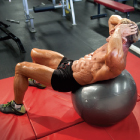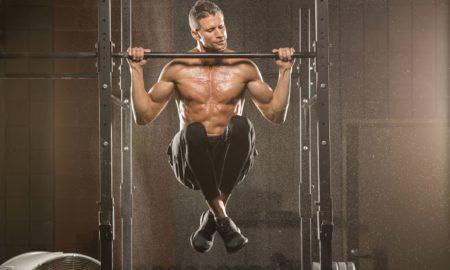 Just because you can perform an exercise doesn’t mean you should. There are many abdominal exercises, and most trainees perform almost all of them. Some are very good, some don’t do what you think they do, and some can cause low-back pain.
Just because you can perform an exercise doesn’t mean you should. There are many abdominal exercises, and most trainees perform almost all of them. Some are very good, some don’t do what you think they do, and some can cause low-back pain.
The most common ab exercise is the most efficient and safest. That’s the crunch. The so-called six-pack muscle—the rectus abdominus—works the most during the crunch. The muscles on the sides of the waist are the obliques. When the oblique muscles contract together, they powerfully flex, or bend, the spine.
There are many models of ab machines, some of which are effective and safe. Older machines such as the Cybex Eagle version were very well designed and effective. You may need to try several ab machines to see if they work for you. One or more may work, or you may not find one that feels right.
Cable crunches are typically an effective exercise with appropriate movement and resistance. Trainees of various sizes can make them work well.
Roman-chair situps have been popular for decades, although the exercise that goes by that name has changed. The modern Roman-chair situp is performed by sitting on a small seat or bench with your feet out in front of you and hooked under a padded bar. You lean back and forth on the seat. There is some degree of abdominal activation, but deep hip flexor muscles that cannot be seen perform most of the work. The hip flexor muscles originate at the lumbar spine—the lower back—as well as the floor of the pelvis, and they insert into the upper-thigh bone. Most of the rocking back and forth movement during Roman-hair situps takes place in the hip. The spine doesn’t round and straighten.
The various forms of leg raises—lying, hanging and kneeups—are similar to the Roman-chair situps in that the deep hip flexor muscles perform most of the work. The visible ab muscles must have a prolonged isometric contraction to hold the pelvis steady so the hip flexors can work. That’s what causes the muscle to “burn.” The work of the deep hip flexor muscles can also create a perception that the so-called lower ab muscles have been “isolated.”
Is there a problem with hip flexor training? Some trainees never have a problem or have only limited problems; however, more often than not they will experience low-back pain from Roman-chair situps, lying leg raises, hanging straight-leg raises or kneeups. The stronger and tighter hip flexors will increase the arch of the low back, which will compress the joints in the spine. That alone can cause pain.
One of the hip flexors, the psoas major, originates on the vertebrae of the lower back and the disks between the vertebrae. It can produce a shearing force on the disk during hip fexor training. If the disk already has a tear or a protrusion, the added force on the disc may cause more pain. A few sports make a major demand of the hip flexors, including gymnastics, some martial arts, figure skating and speed skating. The average trainee does not need to train the hip flexors directly.
Another common abdominal exercise that can be problematic is the twist. The seated twist can be particularly harmful because the pelvis is weight bearing when you’re seated, which means it cannot move much. All the twisting movement occurs in the lowest part of the lower back. Too much rotation can overstretch and tear the disk between the vertebrae, causing acute or chronic low-back pain and also possibly leg pain. Standing twists are somewhat less mechanically stressful; however, the twist is simply not an effective abdominal exercise.
Until next time, train smart, and then train hard.
—Joseph M. Horrigan
Editor’s note: Visit www.SoftTissueCenter.com for reprints of Horrigan’s past Sportsmedicine columns that have appeared in IRON MAN. You can order the books, Strength, Conditioning and Injury Prevention for Hockey by Joseph Horrigan, D.C., and E.J. “Doc” Kreis, D.A., and the 7-Minute Rotator Cuff Solution by Horrigan and Jerry Robinson from Home Gym Warehouse, (800) 447-0008 or at www.Home-Gym.com.




















You must be logged in to post a comment Login